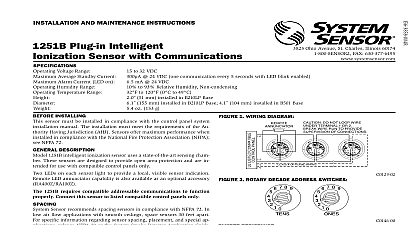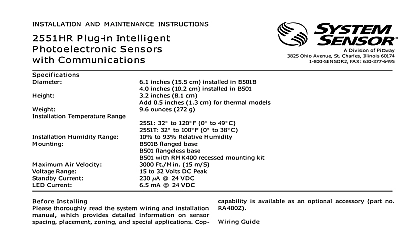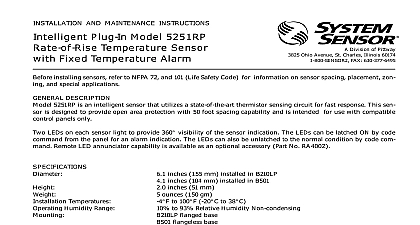System Sensor 2251BR Manual

File Preview
Click below to download for free
Click below to download for free
File Data
| Name | system-sensor-2251br-manual-1456089273.pdf |
|---|---|
| Type | |
| Size | 1.27 MB |
| Downloads |
Text Preview
I Ohio Avenue St Charles Illinois 60174 Fax 630.377.6495 to 32 VDC 24 VDC one communication every 5 seconds with LED blink enabled mA 24 VDC to 93 Relative Humidity Non condensing to 120 0 to 49 2251BR to 158 to 70 2251BR in duct applications 51 mm installed in B210LP Base 155 mm installed in B210LP Base 4.1 104 mm installed in B501 Base oz 147 g AND MAINTENANCE INSTRUCTIONS Intelligent Photoelectric Sensor with Remote Test in Duct Applications Voltage Range Current Alarm Current LED on Humidity Range Temperature Range Load Rating refer to your isolator base module manual for isolator calculation instructions INSTALLING sensor must be installed in compliance with the control panel system manual The installation must meet the requirements of the Au Having Jurisdiction AHJ Sensors offer maximum performance when in compliance with the National Fire Protection Association NFPA NFPA 72 DESCRIPTION 2251BR is a plug in type smoke sensors that combines a photoelec sensing chamber with addressable analog communications The sensor an analog representation of smoke density over a communication to a control panel Rotary decade switches are provided for setting the address LEDs on the sensor are controlled by the panel to indicate sensor status output is provided for connection to an optional remote LED annunciator RA400Z RA100Z 2251BR is used in duct applications with a DNR DNRW testing can be remotely using approved System Sensor test accessories eliminating the for a test coil Only System Sensor approved accessories may be used with the 2251BR requires compatible addressable communications to function Connect the 2251BR sensor to listed compatible control panels only Sensor recommends spacing sensors in compliance with NFPA 72 In air flow applications with smooth ceilings space sensors 30 feet apart specific information regarding sensor spacing placement and special ap refer to NFPA 72 or the System Smoke Detector Application Guide from System Sensor Applications 2251BR is listed for use in ducts See Duct Applications A05 1004 XX for details on pendant mount applications GUIDE wiring must be installed in compliance with the National Electrical Code local codes and any special requirements of the Authority Having Proper wire gauges should be used The installation wires should color coded to limit wiring mistakes and ease system troubleshooting Im connections will prevent a system from responding properly in the of a fire power from the communication line before installing sensors Wire the sensor base supplied separately per the wiring diagram Figure 1 Set the desired address on the sensor address switches see Figure 2 Install the sensor into the sensor base Push the sensor into the base turning it clockwise to secure it in place After all sensors have been installed apply power to the control unit and the communication line Test the sensor s as described in the TESTING section of this manual covers provide limited protection against airborne dust particles during Dust covers must be removed before the sensors can sense smoke sensors prior to heavy remodeling or construction 1 WIRING DIAGRAM DO NOT LOOP WIRE TERMINAL 1 OR 2 WIRE RUN TO PROVIDE OF CONNECTIONS A OPTIONAL WIRING Only System Sensor approved accessories may be used with the 2251BR 2 ROTARY DECADE ADDRESS SWITCHES 0 0 2251BR includes a tamper resistant capability that prevents its removal the bracket without the use of a tool Refer to the base manual for details making use of this capability testing notify the proper authorities that the system is undergoing and will temporarily be out of service Disable the system to unwanted alarms sensors must be tested after installation and periodically thereafter Testing must satisfy the Authority Having Jurisdiction AHJ Sensors offer max performance when tested and maintained in compliance with NFPA 72 sensor can be tested in the following ways Functional Magnet Test P N M02 04 01 or M02 09 00 This sensor can be functionally tested with a test magnet The test mag electronically simulates smoke in the sensing chamber testing the electronics and connections to the control panel Hold the test magnet in the magnet test area as shown in Figure 3 The sensor should alarm the panel Two LEDs on the sensor are controlled by the panel to indicate sensor Coded signals transmitted from the panel can cause the LEDs blink latch on or latch off Refer to the control panel technical docu for sensor LED status operation and expected delay to alarm Smoke Entry The GEMINI model 501 aerosol generator can be used for smoke entry Set the generator to represent 4 ft to 5 ft obscuration as de in the GEMINI 501 manual Using the bowl shaped applicator aerosol until the panel alarms Additionally canned aerosol simulated smoke canned smoke agent be used for smoke entry testing of the smoke detector Tested and aerosol smoke products are Safeguard Industries 30S and CHEK06 used properly the canned smoke agent will cause the smoke detector go into alarm Refer to the manufacturer published instructions for proper of the canned smoke agent aerosol simulated smoke canned smoke agent formulas will vary by Misuse or overuse of these products may have long term ad effects on the smoke detector Consult the canned smoke agent manufac published instructions for any further warnings or caution statements Remote Test 2251BR can be remotely tested using the RTS451 RTS451KEY RTS151 or test accessories Refer to the DNR DNRW manual for wiring Maximum test response time may be up to two communica from the panel sensor that fails any of these tests should be cleaned as described under and retested If the sensor fails after cleaning it must be replaced testing is complete restore the system to normal operation and notify proper authorities that the system is back in operation 3 TEST MAGNET POSITION MAGNET removing the detector notify the proper authorities that the smoke system is undergoing maintenance and will be temporarily out of Disable the zone or system undergoing maintenance to prevent un alarms Remove the sensor to be cleaned from the system Remove the sensor cover by pressing firmly on each of the four removal that hold the cover in place Vacuum the screen carefully without removing it If further cleaning is continue with Step 4 otherwise skip to Step 7 Remove the chamber cover screen assembly by pulling it straight out Use a vacuum cleaner or compressed air to remove dust and debris from sensing chamber Reinstall the chamber cover screen assembly by sliding the edge over the chamber Turn until it is firmly in place Replace the cover using the LEDs to align the cover and then gently it until it locks into place Reinstall the detector Test the detector as described in TESTING Reconnect disabled circuits Notify the proper authorities that the system is back on line 4 SENSOR ASSEMBLY AND TEST NOTE REGARDING SMOKE DETECTOR GUARDS detectors are not to be used with detector guards unless the combina has been evaluated and found suitable for that purpose refer to insert for the Limitations of Fire Alarm Systems Sensor warrants its enclosed smoke detector to be free from defects in materials and workman under normal use and service for a period of three years from date of manufacture System Sensor no other express warranty for this smoke detector No agen


